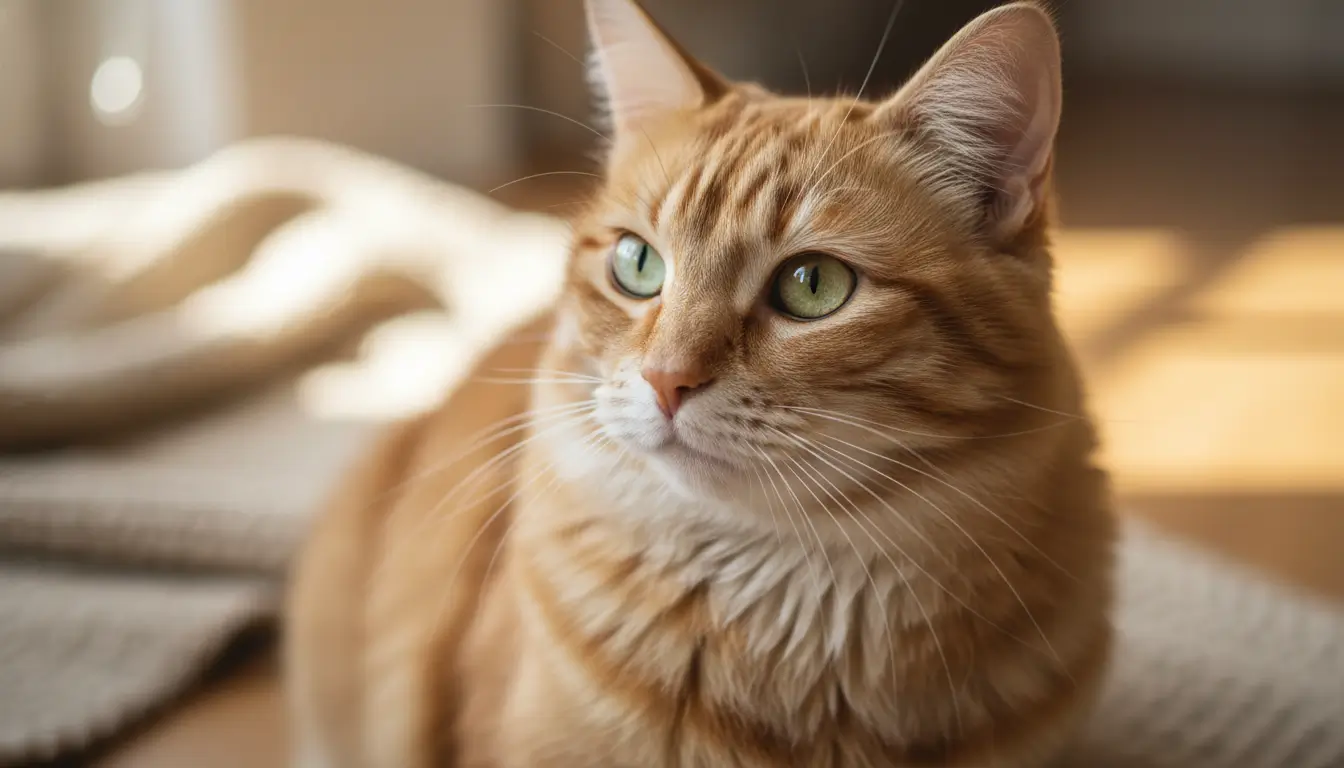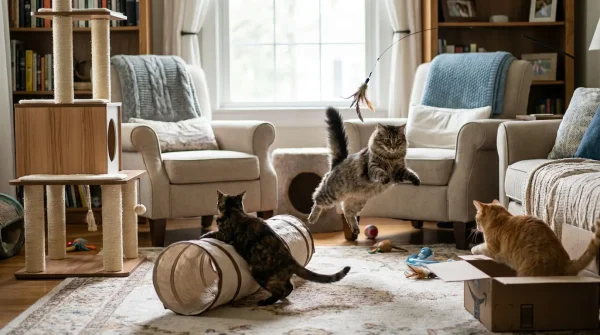Common Cat Behavior Problems: Understanding and Solving Feline Behavioral Issues

How long does it take to resolve cat behavior problems?
Timeline varies by problem severity and cause. Litter box issues may resolve within days to weeks with proper intervention. Aggression between cats may require months of gradual reintroduction. Consistency and patience are essential.
Are some cat breeds more prone to behavior problems?
Certain breeds (Siamese, Bengals, Abyssinians) are more vocal and active, which can be misinterpreted as behavior problems. These high-energy breeds require more environmental enrichment and stimulation to prevent issues.
Provide tall, sturdy scratching posts in various materials (sisal, cardboard, carpet) near sleeping areas and doorways. Double-sided sticky tape on furniture and regular nail trimming can redirect this behavior. Never declaw – it’s inhumane and illegal in many regions.
3. Aggression Toward People or Other Pets
Feline aggression includes biting, swatting, hissing, and attacking. Types of aggression in cats include:
- Play aggression: Resulting from inappropriate play or lack of stimulation
- Fear-based aggression: Triggered by scary stimuli or lack of socialization
- Status-induced aggression: Resource guarding or territorial disputes
- Redirected aggression: Attacking after seeing outdoor cats or other triggers
- Pain-induced aggression: Medical issues causing defensive behavior
Management involves identifying triggers, providing environmental enrichment, consistent play routines, and never punishing aggressive behavior. Separate fighting cats and reintroduce them slowly using scent swapping and positive associations.
4. Excessive Meowing and Vocalization
While some cat breeds are naturally talkative, excessive meowing often indicates a cat behavior problem. Potential causes include:
- Medication conditions (hyperthyroidism, high blood pressure, cognitive decline)
- Attention-seeking behavior
- Hunger or thirst
- Senility in older cats
- Stress or anxiety
Never reward excessive vocalization with attention. Instead, reinforce quiet behavior and address underlying causes. Schedule a veterinary exam to rule out medical issues, especially in senior cats.
5. Nighttime Activity and Sleep Disturbances
Cats are crepuscular, meaning they’re most active at dawn and dusk. However, excessive nighttime zoomies or meowing can disrupt household sleep. This common cat behavior issue often results from:
- Lack of daytime stimulation
- Hunger schedules misaligned with human sleep
- Boredom during human absence
- Insufficient evening play sessions
Implement a routine: 15-20 minutes of vigorous play before bedtime, feed the evening meal after play, and provide puzzle feeders or quiet toys for overnight. Automatic feeders for early morning meals can also help.
Environmental Enrichment: Preventing Cat Behavior Problems
Many feline behavioral problems stem from an environment that doesn’t meet cats’ instinctual needs. The key to prevention is environmental enrichment:
Vertical Territory
Cats feel secure with high perches and vertical space. Provide cat trees, wall-mounted shelves, and window perches to satisfy this natural instinct and reduce territory-related behavior problems.
Interactive Play and Hunting Simulation
Daily play sessions mimicking hunting behavior prevent boredom-based behavior issues. Use wand toys that move like prey, allowing cats to stalk, chase, and “catch” their “kill.” Aim for two 15-minute sessions daily, ending with a small food reward.
Mental Stimulation and Food Puzzles
Food puzzles and treat-dispensing toys engage cats’ problem-solving abilities, preventing destructive behaviors rooted in boredom. Rotate toys regularly to maintain novelty and interest.
Safe Outdoor Access
Catio enclosures, leash training, or window bird feeders provide mental stimulation that prevents indoor-related cat behavior problems while keeping cats safe from outdoor dangers.
Addressing Anxiety and Stress-Related Behaviors
Stress is a significant contributor to cat behavioral problems. Cats are creatures of habit, and changes like moving, new pets, schedule changes, or even furniture rearrangement can trigger stress behaviors.
Signs of feline stress include:
- Over-grooming or pulling out fur
- Hiding or withdrawal
- Inappropriate elimination
- Changes in appetite
- Pacing or restlessness
- Aggression
Feliway pheromone diffusers, maintaining routines, gradual introductions to changes, and providing safe hiding spots can significantly reduce stress-related cat behavior problems.
When to Seek Professional Help
While many cat behavior issues can be resolved with environmental changes and patience, professional intervention is sometimes necessary. Consult a:
- Veterinarian: Rule out medical causes first for any behavior change
- Veterinary behaviorist: For severe aggression, anxiety, or persistent problems
- Certified cat behavior consultant: For environmental and training interventions
Seek immediate help if your cat shows sudden aggression, stops eating/drinking, or exhibits self-harming behaviors.
Conclusion: Patience and Understanding
Resolving cat behavior problems requires understanding that cats aren’t being “bad” – they’re responding to their environment, health, or unmet needs. Punishment is ineffective and damages your relationship. Instead, focus on identifying root causes, providing appropriate outlets for natural behaviors, and seeking veterinary guidance when needed.
Remember that most feline behavioral issues are solvable with patience, environmental modifications, and a deeper understanding of your cat’s unique personality and needs. By creating an enriched environment that respects your cat’s natural instincts, you can prevent many behavior problems before they start and strengthen the bond with your feline companion.
Frequently Asked Questions About Cat Behavior Problems
Can cat behavior problems indicate illness?
Yes! Approximately 80% of inappropriate elimination cases have medical causes. Any sudden behavior change warrants a veterinary examination to rule out pain, cognitive decline, or medical conditions.
Will neutering/spaying stop cat behavior problems?
Neutering significantly reduces territorial marking, roaming, and aggression related to mating behaviors. However, it won’t resolve problems caused by stress, medical issues, or insufficient environmental enrichment.
How long does it take to resolve cat behavior problems?
Timeline varies by problem severity and cause. Litter box issues may resolve within days to weeks with proper intervention. Aggression between cats may require months of gradual reintroduction. Consistency and patience are essential.
Are some cat breeds more prone to behavior problems?
Certain breeds (Siamese, Bengals, Abyssinians) are more vocal and active, which can be misinterpreted as behavior problems. These high-energy breeds require more environmental enrichment and stimulation to prevent issues.
Cat behavior problems can be frustrating for pet owners, but they’re often your feline friend’s way of communicating unmet needs, stress, or underlying health issues. From inappropriate elimination to destructive scratching, understanding common cat behavior issues is the first step toward creating harmony in your home.
Understanding Why Cats Develop Behavioral Problems
Before addressing specific cat behavior problems, it’s crucial to understand the root causes. Unlike dogs, cats are solitary hunters by nature, and their behavior is deeply rooted in instinct. Changes in their environment, routine disruptions, medical conditions, or insufficient mental stimulation can all trigger problematic behaviors.
Veterinary behaviorists note that approximately 80% of inappropriate elimination cases in cats have an underlying medical component. Always consult your veterinarian first to rule out health issues before addressing behavioral aspects.
The Most Common Cat Behavior Problems
1. Inappropriate Urination and Spraying
Inappropriate elimination is the number one reason cats are surrendered to shelters. This frustrating cat behavior problem manifests as urinating or defecating outside the litter box, and can indicate:
- Litter box aversion (dirty box, wrong litter type, poor location)
- Urinary tract infections, kidney disease, or diabetes
- Stress or territorial marking
- Arthritis making box access difficult
- Multi-cat household tensions
Solutions include maintaining pristine litter boxes (scoop twice daily, completely change weekly), providing one box per cat plus one extra, using unscented clumping litter, and placing boxes in quiet, accessible locations. For territorial spraying, pheromone diffusers and reducing household stress can be effective.
2. Destructive Scratching
Scratching is natural feline behavior for claw maintenance, stretching, and territorial marking. The problem arises when cats target furniture instead of appropriate surfaces. This common cat behavior issue stems from:
- Insufficient scratching posts (wrong material, height, or stability)
- Lack of vertical territory
- Boredom or insufficient play
- Anxiety or stress
Provide tall, sturdy scratching posts in various materials (sisal, cardboard, carpet) near sleeping areas and doorways. Double-sided sticky tape on furniture and regular nail trimming can redirect this behavior. Never declaw – it’s inhumane and illegal in many regions.
3. Aggression Toward People or Other Pets
Feline aggression includes biting, swatting, hissing, and attacking. Types of aggression in cats include:
- Play aggression: Resulting from inappropriate play or lack of stimulation
- Fear-based aggression: Triggered by scary stimuli or lack of socialization
- Status-induced aggression: Resource guarding or territorial disputes
- Redirected aggression: Attacking after seeing outdoor cats or other triggers
- Pain-induced aggression: Medical issues causing defensive behavior
Management involves identifying triggers, providing environmental enrichment, consistent play routines, and never punishing aggressive behavior. Separate fighting cats and reintroduce them slowly using scent swapping and positive associations.
4. Excessive Meowing and Vocalization
While some cat breeds are naturally talkative, excessive meowing often indicates a cat behavior problem. Potential causes include:
- Medication conditions (hyperthyroidism, high blood pressure, cognitive decline)
- Attention-seeking behavior
- Hunger or thirst
- Senility in older cats
- Stress or anxiety
Never reward excessive vocalization with attention. Instead, reinforce quiet behavior and address underlying causes. Schedule a veterinary exam to rule out medical issues, especially in senior cats.
5. Nighttime Activity and Sleep Disturbances
Cats are crepuscular, meaning they’re most active at dawn and dusk. However, excessive nighttime zoomies or meowing can disrupt household sleep. This common cat behavior issue often results from:
- Lack of daytime stimulation
- Hunger schedules misaligned with human sleep
- Boredom during human absence
- Insufficient evening play sessions
Implement a routine: 15-20 minutes of vigorous play before bedtime, feed the evening meal after play, and provide puzzle feeders or quiet toys for overnight. Automatic feeders for early morning meals can also help.
Environmental Enrichment: Preventing Cat Behavior Problems
Many feline behavioral problems stem from an environment that doesn’t meet cats’ instinctual needs. The key to prevention is environmental enrichment:
Vertical Territory
Cats feel secure with high perches and vertical space. Provide cat trees, wall-mounted shelves, and window perches to satisfy this natural instinct and reduce territory-related behavior problems.
Interactive Play and Hunting Simulation
Daily play sessions mimicking hunting behavior prevent boredom-based behavior issues. Use wand toys that move like prey, allowing cats to stalk, chase, and “catch” their “kill.” Aim for two 15-minute sessions daily, ending with a small food reward.
Mental Stimulation and Food Puzzles
Food puzzles and treat-dispensing toys engage cats’ problem-solving abilities, preventing destructive behaviors rooted in boredom. Rotate toys regularly to maintain novelty and interest.
Safe Outdoor Access
Catio enclosures, leash training, or window bird feeders provide mental stimulation that prevents indoor-related cat behavior problems while keeping cats safe from outdoor dangers.
Addressing Anxiety and Stress-Related Behaviors
Stress is a significant contributor to cat behavioral problems. Cats are creatures of habit, and changes like moving, new pets, schedule changes, or even furniture rearrangement can trigger stress behaviors.
Signs of feline stress include:
- Over-grooming or pulling out fur
- Hiding or withdrawal
- Inappropriate elimination
- Changes in appetite
- Pacing or restlessness
- Aggression
Feliway pheromone diffusers, maintaining routines, gradual introductions to changes, and providing safe hiding spots can significantly reduce stress-related cat behavior problems.
When to Seek Professional Help
While many cat behavior issues can be resolved with environmental changes and patience, professional intervention is sometimes necessary. Consult a:
- Veterinarian: Rule out medical causes first for any behavior change
- Veterinary behaviorist: For severe aggression, anxiety, or persistent problems
- Certified cat behavior consultant: For environmental and training interventions
Seek immediate help if your cat shows sudden aggression, stops eating/drinking, or exhibits self-harming behaviors.
Conclusion: Patience and Understanding
Resolving cat behavior problems requires understanding that cats aren’t being “bad” – they’re responding to their environment, health, or unmet needs. Punishment is ineffective and damages your relationship. Instead, focus on identifying root causes, providing appropriate outlets for natural behaviors, and seeking veterinary guidance when needed.
Remember that most feline behavioral issues are solvable with patience, environmental modifications, and a deeper understanding of your cat’s unique personality and needs. By creating an enriched environment that respects your cat’s natural instincts, you can prevent many behavior problems before they start and strengthen the bond with your feline companion.
Frequently Asked Questions About Cat Behavior Problems
Can cat behavior problems indicate illness?
Yes! Approximately 80% of inappropriate elimination cases have medical causes. Any sudden behavior change warrants a veterinary examination to rule out pain, cognitive decline, or medical conditions.
Will neutering/spaying stop cat behavior problems?
Neutering significantly reduces territorial marking, roaming, and aggression related to mating behaviors. However, it won’t resolve problems caused by stress, medical issues, or insufficient environmental enrichment.
How long does it take to resolve cat behavior problems?
Timeline varies by problem severity and cause. Litter box issues may resolve within days to weeks with proper intervention. Aggression between cats may require months of gradual reintroduction. Consistency and patience are essential.
Are some cat breeds more prone to behavior problems?
Certain breeds (Siamese, Bengals, Abyssinians) are more vocal and active, which can be misinterpreted as behavior problems. These high-energy breeds require more environmental enrichment and stimulation to prevent issues.





